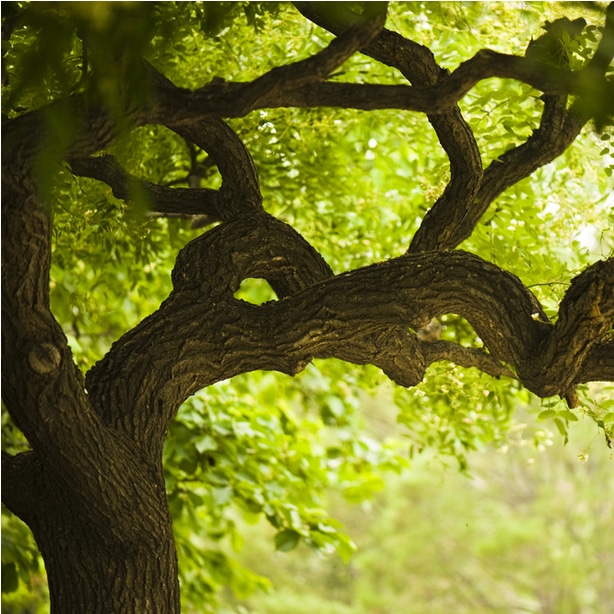Big, bold and beautiful easily sums up the Indian laurel fig tree. It’s sure to be the attention-getting rock star of the landscape.
If you’ve ever considered growing an Indian laurel fig, we cover all the basics. You’ll learn everything from its characteristics, growth requirements, design possibilities, companion plants and considerations.
Continue reading and learn everything you need to know about them and if it’s the perfect tree for you.
If you own a pygmy date palm tree, you might also want to check out our guide on raising a healthy pygmy date palm tree.

General Information
Indian laurel fig also goes by another popular common name Chinese banyan tree. It’s a member of the large fig family Moraceae and genus Ficus. Although now classified as Ficus microcarpa, it once was classified as Ficus nitida.
The tropical tree is native to southern China, India, Australia and New Caledonia. It grows best in consistently warm climates located in USDA hardiness zones 9 to 12.
These are large trees, growing over 50 feet tall and 80 feet wide. The dense, rounded canopy has a spreading habit, filling with glossy green foliage. Trees have an evergreen habit. They remain a large mass of green in fall and winter.

Bark on the trunk and branches are smooth and light gray. Due to its fast growth rate, the wood is considered weak.
In winter, tiny greenish flowers bloom that are inconspicuous. After flowering in spring, small, ½-inch round, greenish fruits form. The inside of each fruit contains the seeds. Seeds readily sprout in the landscape, making it considered invasive in some locations.
Despite its bold green presence, the unique root system is also an attention-grabber. Long, aerial roots form from the branches, hanging to the ground and rooting. The tree produces the most roots in warm, humid climates.
If the aerial roots are allowed to grow, the tree’s area around the trunk can double or triple in width.
Care Guide
Indian laurel fig trees are hardy and durable trees. It definitely won’t be a fussy problem in the landscape when it comes to their care.
Amount of Sun
If you will be growing it indoor, it grows best in an area with bright indirect light. Put it in a place where it doesn’t receive direct afternoon sunlight. You can also use bright artificial light. Rotate the pot weekly to keep the tree’s growth even and straight.
The best place for the ficus to receive bright indirect light indoors is in an east-facing window. This location receives morning sun but not the hot rays of the afternoon. South-facing and west-facing windows can be too hot and sunny, especially during summer and the afternoon.
When growing it outside, plant it in either full sun or partial shade. Generally, sunnier locations produce the best growth.
In desert environments, don’t plant the ficus in a western exposure. These areas can be too hot causing sunburn to the light gray trunk.

Preferred Soil Conditions
Indian laurels aren’t particular in their growing medium. Grow potted figs in a soil-based potting mix that drains well. Outdoors, the tree grows well in a variety of different soils. However, it performs best in sandy or loamy soils. It even performs well in soils that are acidic to alkaline, as well as those that are salty.
Standard potting mixes work well if you will be growing the tree in a pot. You can also make your own by mixing half sterile sand with half potting soil or potting mix.
When growing outdoors, the tree grow well in a variety of soil conditions. It is not very particular about the soil conditions. In fact, the fig tree is known to grow in the crotch of branches in trees or in the cracks of a sidewalk.
For the best growth, plant the Indian laurel fig in sandy or loamy soils. It also grows well in soils that are occasionally moist.
Watering Frequency
Ficus microcarpa trees are tolerant to drought once established.
For potted trees, check the soil’s moisture before watering. Stick your finger into the soil and if the top inch or two is dry, water until it runs from the bottom of the pot. Make sure the pot has bottom drain holes. This assures the tree doesn’t suffer root rot due to soggy conditions.
The watering frequency will depend on how dry your indoor or outdoor conditions are. It can vary from needing to water once every three days to once every week. During winter while the tree goes through dormancy, cut back watering to approximately once every 10 days to two weeks.
The tree prefers a humid environment that is easy to replicate. Mist the potted tree several times weekly with water.
If the ficus is growing in the landscape, water several times weekly while it establishes itself. It can take about eight weeks for the root system to establish itself into the new planting site.
Depending on your local weather conditions, water established trees every week to two weeks. If your outdoor conditions are extremely hot and dry, you may have to water more frequently. This is especially true if you live in a location with hot summers or desert environments.
During winter, you can cut back to watering every two weeks. The tree stops actively growing during the cooler months. Always water deeply.

Fertilization
Fertilize Indian laurel fig trees grown in pots and in the landscape during the growing season while plants are actively growing. The growing season is spring throughout summer.
Feed potted Indian laurel fig trees every six weeks. Use a water-soluble blend for houseplants applied according to package directions on amounts. You can apply the fertilizer when you would typically water.
For laurels grown in the landscape, feed every six to eight weeks. Use a general-purpose blend like a 10-10-10.
Spread the fertilizer under the tree’s canopy. Make sure you don’t allow the fertilizer to touch the tree’s trunk to prevent burns. Scratch it into the soil’s surface and water after applying.
Stop feeding the tree in fall when it stops actively growing. You can resume fertilization in spring when growth resumes.
If you forget to fertilize, don’t fret too much. Most likely, this durable tree won’t even skip a beat.
Design Ideas
Indian laurel fig trees fulfill a variety of design desires in landscapes. Due to its large size and spreading canopy, it can overtake smaller yards. You can control its size by growing the tree in pots. Regardless of how you grow it, the ficus will definitely bring a tropical feel to the area.
The tree is a popular ornamental tree utilized in frost-free areas like southern California and Florida. Its dense foliage and robust growth makes it one of the popular street trees used in consistently warm locales. It’s also a common tree used in parks and gardens.
If you’re looking for big shade trees with a fast growth rate, an Indian laurel fig fits the bill. It’s a good tree to relax under and beat the summer heat. However, with its massive mature size and spread, it fits better into larger yards.
The ficus also works well adding privacy to the yard. It’s also used as a screening plant planted as a hedge. Regular pruning will keep its size in check.
Indian laurel fig’s durability and hardiness makes it a popular choice used in bonsai.

Companion Plants
Various trees, shrubs and perennials work well as companion plants. Many of the companion plants have flowers, which add color to compliment the tree’s glossy green foliage. When selecting companion plants, be sure to choose those that thrive in the same growing conditions as the fig. For proper spacing, always consider a plant’s mature size.
Companion Trees
Some of the trees that work well as companions include:
- Queen Palm (Syagrus romanzoffianum)
- Pygmy Date Palm (Phoenix roebelenii)
- Silk Floss Tree (Chorisia speciosa)
- Yellow Trumpet Tree (Tabebuia chrysotricha)
Companion Shrubs
Companion shrubs include:
- Yesterday-Today-Tomorrow (Brunfelsia pauciflora)
- Tropical Hibiscus (Hibiscus rosa-sinensis)
- Dwarf Schefflera (Schefflera arboricola)
- Philodendron (Philodendron spp.)
Perennial Companions
Perennials add color and texture season after season. Some examples include:
- Lily-of-the-Nile (Agapanthus africanus)
- Heliconia (Heliconia spp.)
- Daylily (Hemerocallis spp.)
- Queen’s Tears (Billbergia nutans)
Other Considerations
Although once a popular ornamental, Indian laurel fig is now considered highly invasive in Florida and Hawaii. The tree’s fast growth rate, invasive root system and ability to reseed make it an undesirable landscape addition in many locations. However, if planting one in your landscape there are important considerations when selecting an appropriate location.
Due to the tree’s fast growth rate, the wood is weak and prone to breakage. Don’t plant it close to a structure where falling branches can cause damage. You also don’t want to plant it close to powerlines.
The large, invasive root system can lift sidewalks, walkways and driveways. They can also lift areas of the lawn making it harder to mow.
You also don’t want to plant it close to water lines or a septic system. The invasive roots can create potential expensive damage to the area.
Although the Indian laurel fruit isn’t edible to humans, birds love to eat it. The seeds readily reseed into areas creating problems with unwanted growth. The tree has naturalized into areas where it’s taking over native populations of plants.

